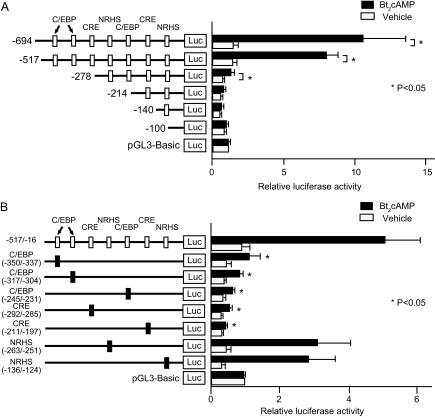Figure 2.
Identification of regulatory regions responsible for cAMP-dependent aromatase promoter I.3/II activity in LSMCs. A, Reporter plasmids containing the 5′-flanking region of human aromatase promoter I.3/II with serial deletions (−694, −517, −278, −214, −140, and −100 to −16 bp) were transfected into LSMCs. Relative positions of the cis-regulatory elements are indicated as white boxes. Statistical analysis was performed for each construct comparing promoter activity with or without Bt2cAMP treatment. *, P < 0.05 (Wilcoxon signed rank test). B, Site-directed mutagenesis for each cis-regulatory element was performed as described in Materials and Methods, and each reporter plasmid was transfected into LSMCs. White boxes represent positions of each cis-regulatory element within the promoter I.3/II region, and black boxes represent the cis-regulatory sequence selectively disrupted by site-directed mutagenesis in each construct. Numbers below the name of each cis-regulatory element indicate the distance from the transcription start site in the promoter I.3/II region. Statistical analysis was performed comparing Bt2cAMP induction of each mutant construct with the −517/−16 bp construct. *, P < 0.05 (ANOVA). Luciferase (Luc) activity was normalized to cotransfected renilla luciferase activity and is reported as the average of data from triplicate experiments + sem. The empty luciferase vector, pGL3-Basic, was arbitrarily assigned a unit of one. Results are reported as an average from LSMCs from six subjects.

